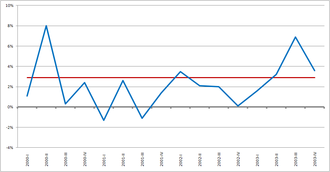Early 2000s recession
This article needs additional citations for verification. (March 2022) |

The early 2000s recession was a decline in economic activity which mainly occurred in developed countries. The
This recession was predicted by economists because the boom of the 1990s, accompanied by both low inflation and low unemployment, slowed in some parts of East Asia during the 1997 Asian financial crisis. The recession in industrialized countries was not as significant as either of the two previous worldwide recessions. Some economists in the United States object to characterizing it as a recession since there were no two consecutive quarters of negative growth.[citation needed]
United States


After the relatively mild 1990 recession ended in early 1991, the country hit a belated unemployment rate peak of 7.8% in mid-1992. Job growth was initially muted by large layoffs among defense related industries.[2] However, payrolls accelerated in 1992 and experienced robust growth through 2000.[3]
Predictions that the bubble would burst emerged during the
According to the National Bureau of Economic Research (NBER), which is the private, nonprofit, nonpartisan organization charged with determining economic recessions, the U.S. economy was in recession from March 2001 to November 2001,[5] a period of eight months at the beginning of President George W. Bush's term of office. The NBER's Business Cycle Dating Committee determined that a peak in business activity occurred in the U.S. economy in March 2001. A peak marks the end of an expansion and the beginning of a recession. The determination of a peak date in March is thus a determination that the expansion that began in March 1991 ended in March 2001 and a recession began.[5] The expansion lasted exactly 10 years, the longest in the NBER's chronology.[6]
However, economic conditions did not satisfy the common shorthand definition of recession, which is "a fall of a country's real gross domestic product in two or more successive quarters", and has led to some confusion about the procedure for determining the starting and ending dates of a recession.
The NBER's Business Cycle Dating Committee (BCDC) uses monthly, rather than quarterly, indicators to determine peaks and troughs in business activity,[7] as can be seen by noting that starting and ending dates are given by month and year, not quarters. However, controversy over the precise dates of the recession led to the characterization of the recession as the "Clinton Recession" by Republicans, if it could be traced to the final term of President Bill Clinton. BCDC members suggested they would be open to revisiting the dates of the recession as newer and more definitive data became available.[8] In early 2004, NBER President Martin Feldstein said:
It is clear that the
revised data have made our original March date for the start of the recession much too late. We are still waiting for additional monthly data before making a final judgment. Until we have the additional data, we cannot make a decision.[8]
However, in 2008, the NBER confirmed that the recession started in March 2001.[9]
From mid-1999 to 2001, the
The Labor Department estimates that a net 1.735 million jobs were shed in 2001, with an additional net 508,000 lost during 2002. 2003 saw a small gain of a mere 105,000 jobs. Unemployment rose from 4.2% in February 2001 to 5.5% in November 2001, but did not peak until June 2003 at 6.3%, after which it declined to 5% by mid-2005.
Canada
However, in the wider economy, Canada was surprisingly unhurt by these events. While growth slowed, the economy never actually entered a recession. This was the first time that Canada had avoided following the United States into an economic downturn. The rate of job creation in Canada continued at the rapid pace of the 1990s. A number of explanations have been advanced to explain this. Canada was not as directly affected by 9/11 and the subsequent wars, and the downward pressure of these events was more muted. Canada's fiscal management during the period has been praised as the federal government continued to bring in large surpluses throughout this period, in sharp contrast to the United States. Unlike the United States no major tax cuts or major new expenditures were introduced. However, during this time, Canada did pursue an expansionary monetary policy in an effort to reduce the effects of a possible recession. Many provincial governments suffered greater problems with a number of them returning to deficits, which was blamed on the fiscal imbalance. 2003 saw elections in six Canadian provinces and in only one did the governing party not lose seats.

